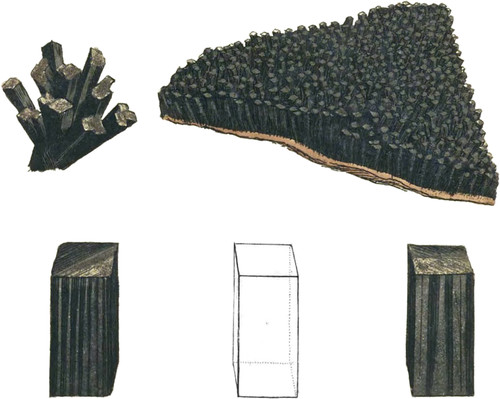 Enlarge
Enlarge
British Mineralogy
Oxide of Manganese
- Class 3. Metals.
- Order 1. Homogeneous.
- Gen. 2. Manganese.
- Spec. 2. Oxide.
- Div. 1. Crystallized.
- Var. 1. Crystal primitive.
- Gen. Char. Spec. Grav. 6.85, somewhat malleable. Colour grayish white, very difficult of fusion, even more so than iron. Colours glass violet. Does not combine with sulphur.
- Spec. Char. Combined with oxygen.
- Syn.
- Manganese mineralized by oxygen, Kirw. v. 2. 291.
- Gray manganese ore, Syst. Min. Jameson.
- Braunstein. Emmerl. v. 2. 522.
- Manganese oxydé. Haüy, v. 4. 243.
Manganese (which was first discovered to be a new metal by Bergman), and which has since been found in native state by Mr. La Perouse, in the valley of Vicdessos, near Sem, in the neighbourhood of Foix, Pyrénees, who says it is imbedded in oxide of manganese; is of a silver gray colour with a metallic lustre; divergingly foliated texture, somewhat malleable, and that it soils the fingers. Not knowing of its being found hitherto in Great Britain, we give this short account of it, and shall be glad to be favoured with any specimens which may be met with hereafter We describe with much pleasure the present specimen of crystallized oxide, as propitious to an expectation that Great Britain nearly includes all that is essential to a knowledge of mineralogy, very few genera being excepted.
Mines have been worked in many parts of Great Britain for oxide of manganese. I have some specimens from Mendip Hills in Somersetshire, crystallized in small short rhomboidal prisms. The one figured is crystallized in elongated ones, which have straiæ on their sides that agree with the fracture. We also find the apex show signs of a diëdral tetraëdral summit.
The upper right hand figure is nearly the natural appearance and size of the specimen; the prisms standing irregularly and joining near the base, where they stand upon sulphate of barytes, &c. The gangue is a sort of stratified micaceous grid, through a stratum of which it runs in veins. In a mass sent me from Aberdeen, the manganese includes crystallized sulphate of barytes, &c. as trap sometimes does other stones. The left hand upper figure is magnified, and shows how irregularly the crystals stand on the mass in some parts. The left hand bottom figure shows the upright striæ on the prism, and the apex exhibits the diagonal striæ, and on some crystals a slight beginning of the two faces which sometimes meet in the centre. The left hand figure shows these striæ meeting in four directions to the centre, with the cross diagonals, giving signs of 4 or more faces. The prism is sometimes truncated so as to form eight sides. Haüy knew of no other than these eight-sided ones, with 2 or 4 terminal faces.
We first read of the short tetraëdral prisms of oxide of manganese in Catal. de Raab. v. 2. 130, from Naila, in the margravate of Bareith, in Germany, and soon after of the rhomboidal tetraëdral prisms, neatly truncated at their extremities, from Ilmenau in Saxony. These of course are in Mr. Greville’s matchless collection; we find the latter mentioned, as from Ilfield, in Dr. Babington’s catalogue of the collection, now belonging to sir John St. Aubin, p. 255. We are glad to be possessed of British specimens from the works near Aberdeen, which I have been given to understand were first discovered by the Rev. Mr. Smith. My friend, Mr. James Reid, among other similar favours, procured me the specimen figured, some time in the year 1803. It agrees exactly with the two last specimens mentioned in Catal. de Raab., in which the word truncated is certainly superfluous, rhomboidal prisms simply, being assuredly meant. This is considered as the primitive form by Haüy.
Oxide of manganese is used in glass-houses in small quantities, to clear and discolour glass by giving up some of its oxygen, and so completing the vitrification of the iron or other colouring ingredients. It is used as a pigment or an ingredient in printer’s ink, and to procure oxygen gas from, for many purposes, viz. as a medicine; or for oxygenizing muriatic acid for bleaching, &c. About two quarts of this gas may be obtained from an ounce of oxide of manganese.

